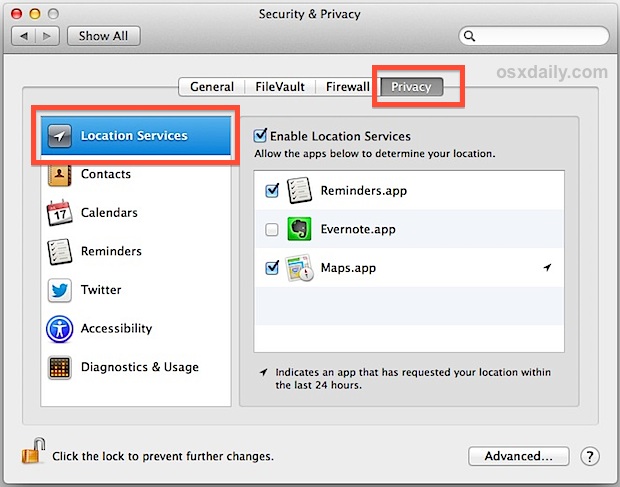How to See & Control What Apps Use Location Data in Mac OS X

Do you want to control which apps can use your location on Mac? Want to see exactly what apps are using your location data on the Mac? Mac OS X now has the ability to easily view and manage which applications can access a users location data.
This article will review first how to determine what apps are using location data, and second how to change and control what apps are allowed to use location data on Mac OS.
Mac users who also have iOS devices should find the initial indicator to be a familiar arrow icon that resides alongside other status bar icons and symbols. The location indicator arrow appears in the menubar of Mac OS X when an app is attempting to use location services, this provides the first clue and is found along with the other menu bar items on a Mac. With some applications it may be obvious why they are using or trying to use location data and seeing that indicator icon may be of no surprise, but other apps may be more curious, and the arrow icon may appear when using a seemingly unrelated app.
Remember, Mac OS X will provide the user with a dialog box to approve or deny the usage of location data. Only the apps that have been previously approved will appear in the menu bar, as apps that have been denied will not find them accessible. Even so, let’s cover how to determine exactly what apps are using location data, and also how to change and control what apps can use location on the Mac.
How to Determine What App is Using Location Services in Mac OS X
To quickly see what app is using and access location data, simply click on the arrow icon in the menu bar to pull down a list of all applications that are attempting to use location services:

The menu bar items are informational, but not directly actionable without going into the privacy control panel. You can jump to that immediately by choosing “Open Privacy Settings” through this menu bar, or by accessing it from System Preferences as outlined below, which provides granular control over application-specific location usage.
How to Control What Apps Can Use Location Data on the Mac
Again like the iOS world, Mac OS X provides fine tuned controls for location data usage, allowing for various levels of location sharing depending on what fits the user and their app preferences.
You can access the Location Services Privacy menu through the method outlined above in the menubar, or through the Mac System Preferences which we’ll outline below:
- Open System Preferences from the Apple menu
- Go to “Security & Privacy”, and then choose the “Privacy” tab
- Select “Location Services” from the left side of the panel
- Adjust location service allocations as desired here:
- Check / Uncheck “Enable Location Services” to completely turn the feature on or off
- Uncheck the box next to a specific app to deny that application Location Service data

Apps that have requested location data within the past 24 hours will be shown with the familiar arrow icon alongside their name in this preference panel. This is another way of seeing what apps are trying to use location data, and also a way of determining recent attempts if you briefly noticed the menu bar icon flash and disappear to signify location usage.
Even apps that have been rejected for using location services will appear in this list, which can be helpful in reversing location settings changes should you wish to allow or deny the app again in the future.


Completely disabling location services is a possibility here (handled slightly different in prior versions of Mac OS X), though for most users it’s best to leave the feature turned on and only selectively allowed on a per-app basis. This allows for convenient features like maps, directions, traffic and road incidents, and location reminders, while still providing a layer of privacy and control that many users appreciate.

